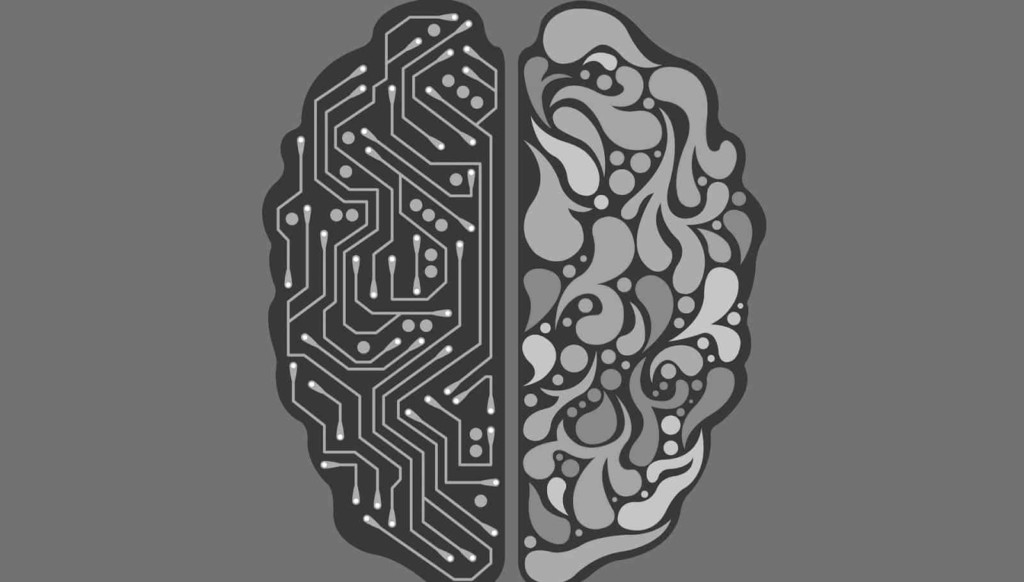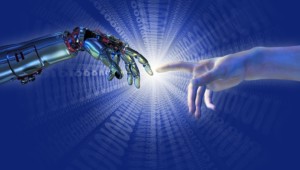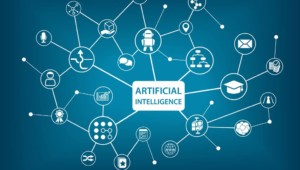The Rise of AI: New Rules for Super T Professionals and Next Steps for EdLeaders
Key Points
-
The rise of artificial intelligence, especially generative AI, boosts productivity in content creation–text, code, images and increasingly video.
-
Here are six preliminary conclusions about the nature of work and learning.

For more on AI in education, check out recent publication that highlights companies and organizations who are paving the way. Learn More
We are a few months into a new age of human-computer interaction, an era that will change how we work, our aspirations and even our identity. The rise of artificial intelligence, especially generative AI, boosts productivity in content creation–text, code, images and increasingly video.
An OpenAI/Penn study suggests around 80% of the U.S. workforce could have at least 10% of their work tasks affected by the introduction of large language models (LLM), while 19% of workers may see at least 50% of their tasks impacted. Unlike prior waves of automation, higher-income jobs face greater exposure to LLM capabilities.
With tools built on top of LLM, including sector-specific models such as BloombergGPT in finance and MedPalM2 in healthcare, about half of all worker tasks in the US could be completed significantly faster at the same level of quality.
With the caveat that none of us knows how AI will influence life and work, the following are six preliminary conclusions about the nature of work and learning.
1. AI narrows the skill gap.
Generative AI augments content creation and boosts response capabilities, especially for low-skill workers and learners. A new Stanford/MIT study of customer support agents showed that generative AI increased productivity by 14% on average with the greatest impact on novice and low-skilled workers. AI also narrowed the productivity gap between lower-skilled workers and workers with more skills.
Next generation AI tutors will accelerate skill-building (even better than current adaptive systems i-Ready, DreamBox, i-Station, ALEKS) by modifying path as well as level.
MIT’s David Autor optimistically told NPR “that we could use AI to expand job opportunities, lower barriers to entry to a whole range of occupations, and reduce inequality.”
Accelerated skill building and real-time skill augmentation are promising developments and may begin to level the skills playing field but the experience gap (below) is likely to widen along with the wealth gap.
New rule: always be on a skill sprint–getting better at something useful and/or meaningful using smart tools.
Tom Vander Ark
2. AI augmented workforce values experience.
New productivity and quality expectations may raise employment experience requirements. “Employers might reasonably expect entry-level workers to be conversant with AI and something like 50% more productive. And this means while the skills gap may narrow, the experience gap could become a chasm,” said Ryan Craig, Achieve Partners (a private equity firm that invests in hiring intermediaries).
“The bar for good entry-level jobs will be higher, meaning fewer jobs that look entry level, and rendering career launch even more difficult,” said Craig. He continued, “Employers will only want to onboard entry-level workers who’ve already proven they can do the job…The problem will become even more acute with the emergence of industry-specific large language models”
“In the ChatGPT era, the future of career launch and socioeconomic mobility will depend on scaling pathways that not only teach, but also provide relevant work experience. CTE and youth apprenticeships will become priorities for every high school,” said Craig.
“As generative AI transforms entry-level jobs and puts a premium on experience, these earn-and-learn models are likely to be the best bet for helping millions of young people launch careers,” added Craig.
Author of the forthcoming book Apprentice Nation, Craig thinks work-based learning (client projects, internships and apprenticeships) can narrow the experience gap for high school and college students.
New rule: get experience as soon as you can in the area in which you want to contribute. Start using smart tools, especially sector specific tools, whenever you can.
Tom Vander Ark
3. AI makes Super T professionals.
For three decades, talent consultants have referred to T shaped professionals as having the breadth to collaborate across disciplines with the depth of expertise in a specific field. For individuals and teams, generative AI extends breadth and, with sector specific tools built on LLMs, extends expert-level depth.
BloombergGPT answers financial questions, conducts analysis, and builds projections. Google’s Med-PaLM2 answers medical questions and supports diagnosis (and passes medical licensing exams). GitHub Copilot and Replit Ghostwriter generate, complete, and explain code. All of these, to Craig’s point, are most useful to workers with some sector knowledge and experience.
AI changes the vocational identity of augmented professionals. It affords a new sense of purpose and agency–expanding the scope of the change you can make in the world. Suddenly, you can be a 5x coder, maybe a 10x coder, doing more than a skilled team could accomplish in the same period of time.
AI may not take your job, but a clever, sector-knowledgable augmented (Super T) human will.
New rule: update your vocational identity–you are a Super T professional with new superpowers. You can do more than you ever thought possible.
Tom Vander Ark
4. Augmented work requires new skills.
In a May research brief, Microsoft said “As AI reshapes work, human-AI collaboration will be the next transformational work pattern—and the ability to work iteratively with AI will be a key skill for every employee.”
“ChatGPT and the underlying technology of large language models is likely to change nearly every job that involves writing, analysis or otherwise processing information…someone with prompt engineering skills will find themselves in demand across a growing range of professions, from coding and engineering, to marketing, management, law, research, product development, administration and many others,” said ASU’s Andrew Maynard.
Prompt engineering requires analytical judgment, intellectual curiosity, and creative evaluation–three of the top skills identified by Microsoft. Leaders they surveyed said “it’s essential that employees learn when to leverage AI, how to write great prompts, how to evaluate creative work, and how to check for bias.”
Source: Will AI Fix Work? Microsoft
Problem finding, a precursor to prompt engineering, is spotting work worth doing–work that matters to you and your community. KEEN, a network of 55 engineering schools committed to developing an entrepreneurial mindset, calls it opportunity recognition which leads to solution design and impact delivery. It takes curiosity, willingness to explore contrarian views, connections for many sources, and a commitment to creating value for communities.
New rule: spend time every day opportunity spotting. Don’t just watch the news; study trends, make connections, spot new ways to add value and make a difference.
Tom Vander Ark
5. Be a better you.
With the widespread use of generative AI, we will all be producing less and editing and curating more. Editing requires Models of Excellence–you have to know what good looks like. Editing also requires a personal narrative. To be a better communicator than ChatGPT, you have to be a great storyteller.
Kevin Kelly told Steve Levitt that in the age of big prediction models, there is value in being unpredictable. “A really worthy goal is to arrange your life or become something where you’re not predictable by A.I. Again, A.I. is a prediction thing. It’s going to try and guess what the next average human would say, and you don’t want to be the average human if at all possible. You want to be you.”
And, while you’re being your best creative self, get the facts right. In the early models of generative AI we’re co-creating with tools that hallucinate convincingly. Add an explosion of deepfakes and editing for creativity AND accuracy is the new challenge.
New rule: as your own editor-in-chief, add your own story but get the facts right.
Tom Vander Ark
6. Augmented work changes pathways bets.
The dynamic velocity of the employment market makes postsecondary learning more important than ever. However, it is more important than ever to pursue learning with a sense of purpose and a plan for employment. Debt without a degree and related employment is the new worst case scenario. If you can get a full scholarship to a selective college take it and start building work experience. If not, consider an earn and learn ladder, find an employer willing to pay for training and development.
Liberal arts might be more valuable than ever–they build the knowledge, skills, and mindsets that make us most human–but don’t pay too much for a degree without building experience and employability.
New rule: gain college credit and industry-recognized credentials in high school. Don’t take on college debt without an informed sense of purpose and a clear path to employment an/or entrepreneurship (i.e., purpose, skills, experience, and connections).
Tom Vander Ark
Next Steps for EdLeaders
Start the conversation with staff and community about the age of human-computer interaction. They need to hear from you. You don’t need all the answers, you just need to show up and acknowledge that we’re living through something new and important.
Banning generative AI isn’t an option. After an initial ban, NYC Chancellor David Banks said, “New York City Public Schools will encourage and support our educators and students as they learn about and explore this game-changing technology while also creating a repository and community to share their findings across our schools.” They launched a Day of AI to explore new possibilities.
Encourage exploration and use with disclosure. Take a human-centered, teacher-in-the-loop approach (see US ED OET Recommendations for more). Update your code of conduct (and your acceptable use policy as needed) and give instructional staff the ability to establish parameters around when and how students should engage in AI to complete an assignment or project.
Update your digital citizenship training and introduce the ethics of AI beginning not later than middle school.
Start iterating assessment and grading practices. Assume that any work done outside of school is augmented.
Expand access to Real World Learning including internships, client projects, and entrepreneurial experiences. Expand access to accelerated pathways including college credit and credentials.
This change won’t be easy but this new era means young people can do more than ever–more than we dreamed possible even a few months ago. It’s time to invite them, especially learners furthest from opportunity, into a future of possibility, into work that matters. Their potential just got bigger and better.







Enrique Aguirre-Hall
EAI = Ethical Artificial Intelligence, the challenge of digital education. Are the educational systems worldwide up to it?